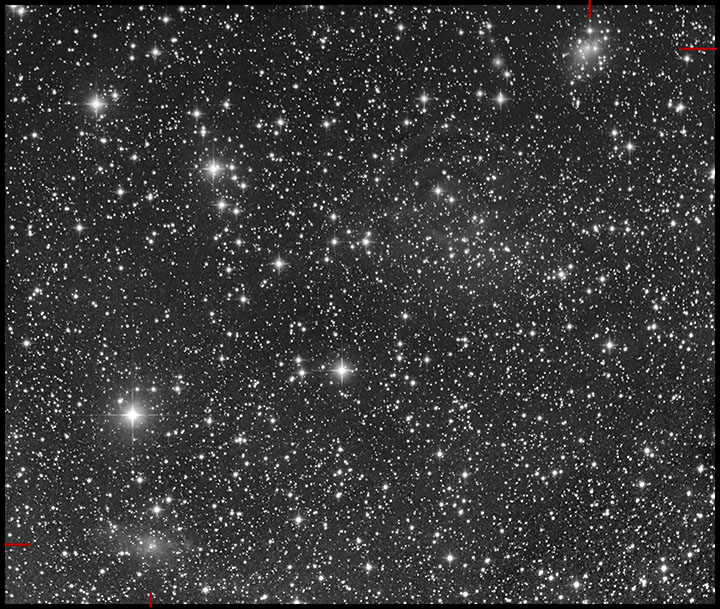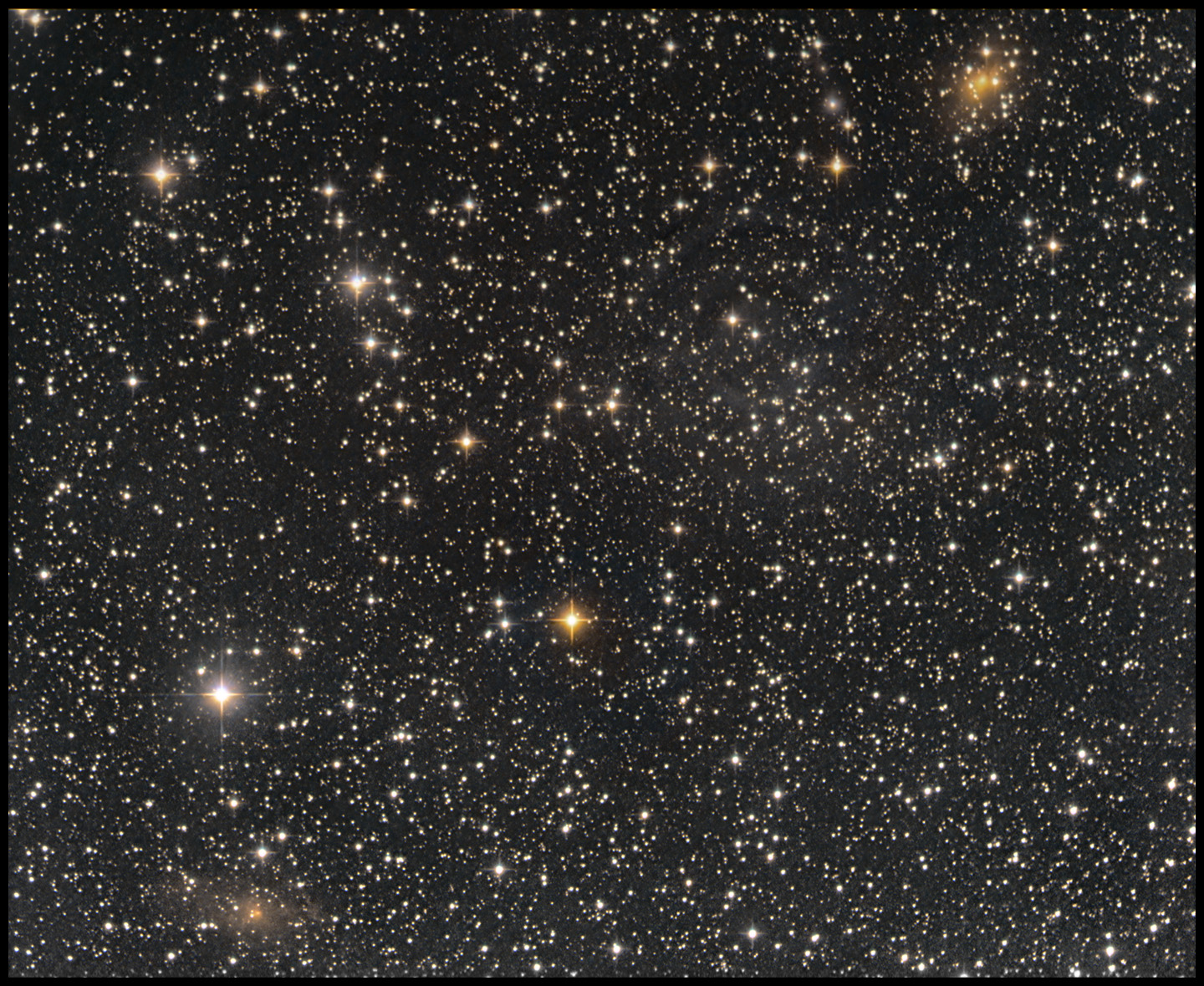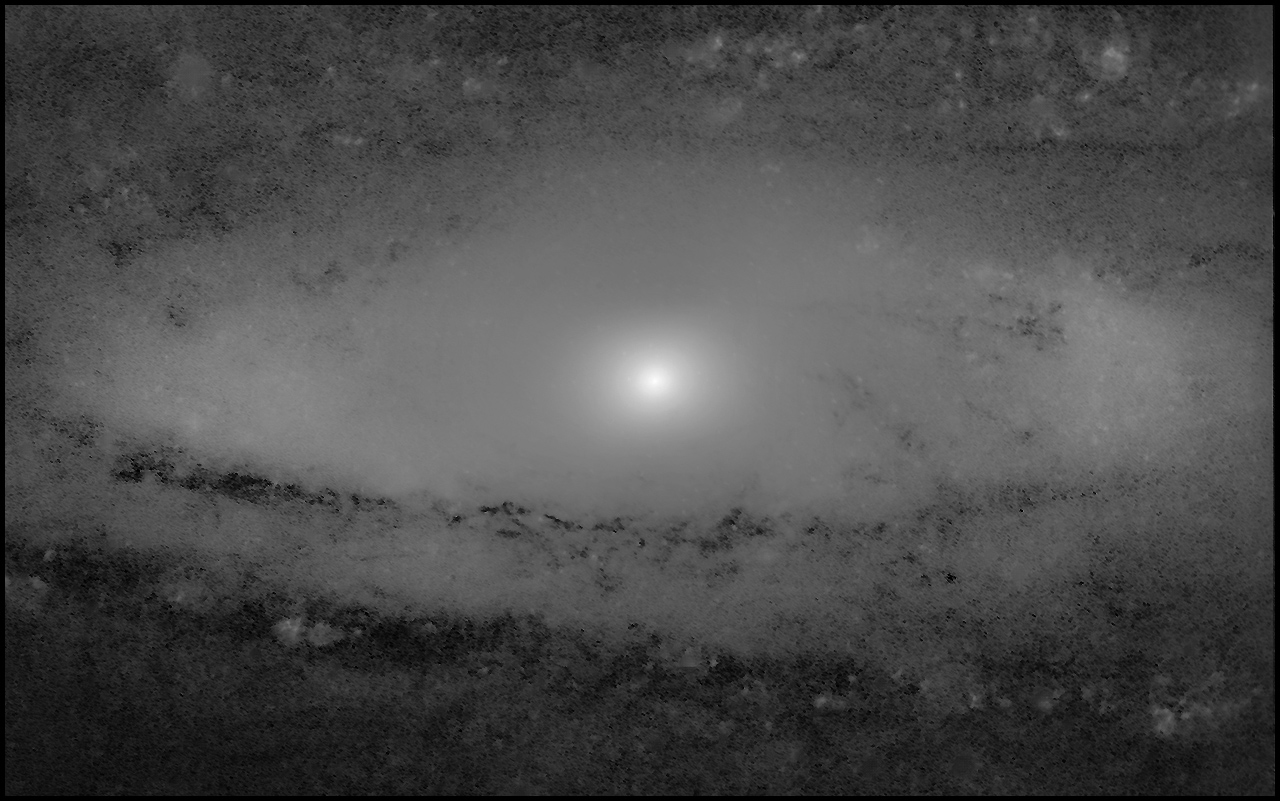| |
Left in the Dust
11/24/2022. If it weren't for the dust this would be one of the most spectacular, oft-photographed bits of the entire sky. The field is one degree from corner to corner -- twice the width of the Moon. In the upper right corner we have Maffei-1 and in the lower left Maffei-2. A very faint and diffuse nebula, Sharpless-197, lies between them, middle of the frame, closer to the upper right. Nevermind that, but its visibility reassures me that the image is decently flat-fielded.

57 x 180s exposures
AT10RC @ F4.8, ASI1600MM at -15C & unity gain
Click it if you can spare a megabyte of bandwidth.
The faint fuzzies in the corners are the centers of substantial galaxies about 10 million light-years away glimpsed through the foreground stars of Cassiopeia. Maffei-1 and -2 lie almost exactly on the "galactic equator," the plane of the Milky Way's starry and dusty disk. There are a lot of stars in that direction, but nost are well out in the next spiral arm of the Milky Way so few appear very bright (the brightest star in that frame is about 5x too faint to be seen without binoculars). Just to the north of this field, out of view to the top and to the left are two large, flashy, bright nebulae, the so-called "Heart" and "Soul" nebulae lit up by brilliant clusters of stars. Nothing lights the dust and gas in this view. It soaks up light like the soot it largely is and leaves only the dark.
Last week, I went on about IC 342, a galaxy discovered by W. F. Denning (or by E. E. Barnard, depending on who's telling it). Together with the not quite so obscured IC 342, these two apparently fainter galaxies form a group similar to "the Local Group" -- the Milky Way, M31, and M33. In 1968, Paolo Maffei suspected the nature of these two after inspecting near-infrared photographs of the area. His more detailed analysis show that severely dimmed Maffei-1 is an elliptical galaxy and fainter Maffei-2 is a spiral. Only their bright cores shine through the dust of the Milky Way. The exact amount of dimming remains uncertain, but it is on the order 4-6 magnitudes (see Fingerhut 2007, DOI: 10.1086/509862; ApJ, Feb 1, 2007). Let's just say five magnitudes: only one photon out of every hundred makes it through to Earth.
If we could see them without looking through the dust, they would overflow this field, filling their respective corners of the frame. Maffei-2, at lower left, would exhibit a compelling swirl of starry arms; Maffei-1 would be a large, amorphous glow filling at least the upper right quarter of this frame.
I honestly didn't expect to "see" them as well as I did last night. Color to come when I have another satisfying night with the Maffei twins.
Note to self: center the camera on 2h40m45s +59d41', rotation 325. The image above is rotated 180 in processing to put N at upper left.
11/28/2022. Got the color data: 45 minutes each of R and B and added it to the luminance channel above.

Luminance as above plus 15 x 180s R, 15 x 180s B, synthesized G.
Guess what happens if you click it.
Want to see what a dusty place a galaxy like ours is? Take a look at a similar galaxy from the outside. Here's M31, looking across the disk from one side to the other. All the foreground stars have been digitally removed, leaving only the Great Andromeda Galaxy's massed, unresolved stars and its nebulae, both bright and dark:

14 x 600s H-a. Stars removed using PI/Starnet.
An aside about that last photo: it's comprised of images taken in two sessions. Mostly, I was just looking for something to keep the gear working between the time NGC 7000 goes down behind the treetops and the Maffei galaxies emerge from a tree that blocks much of the eastern sky. Thing is, the second night, I lined up the telescope, initiated the guider, chose guide stars, but never pushed the button to start guiding. I made nine 10-minute exposures at 1200mm on an AP Mach1 mount without guiding. Seven of the nine were not bad at all -- not as good as if I had started the guider, but plenty good enough to mix with the first night's take. This is why we buy the good stuff.
:: top ::
|